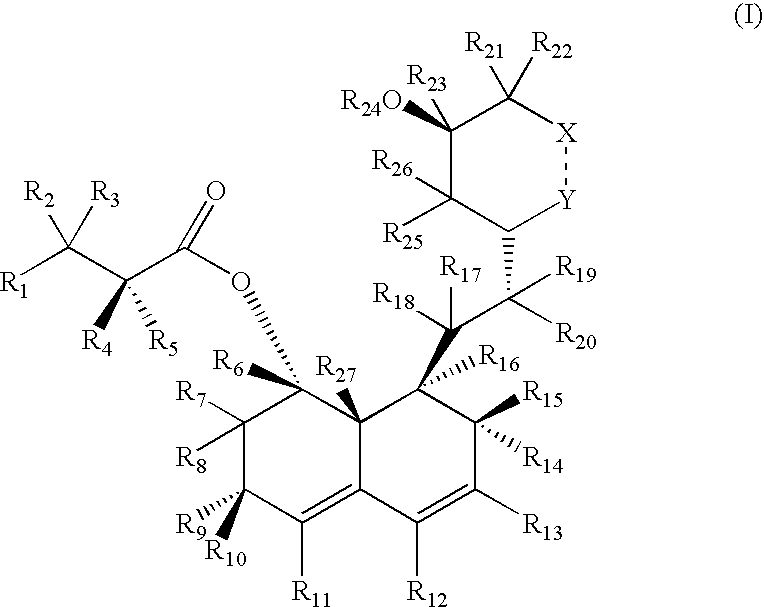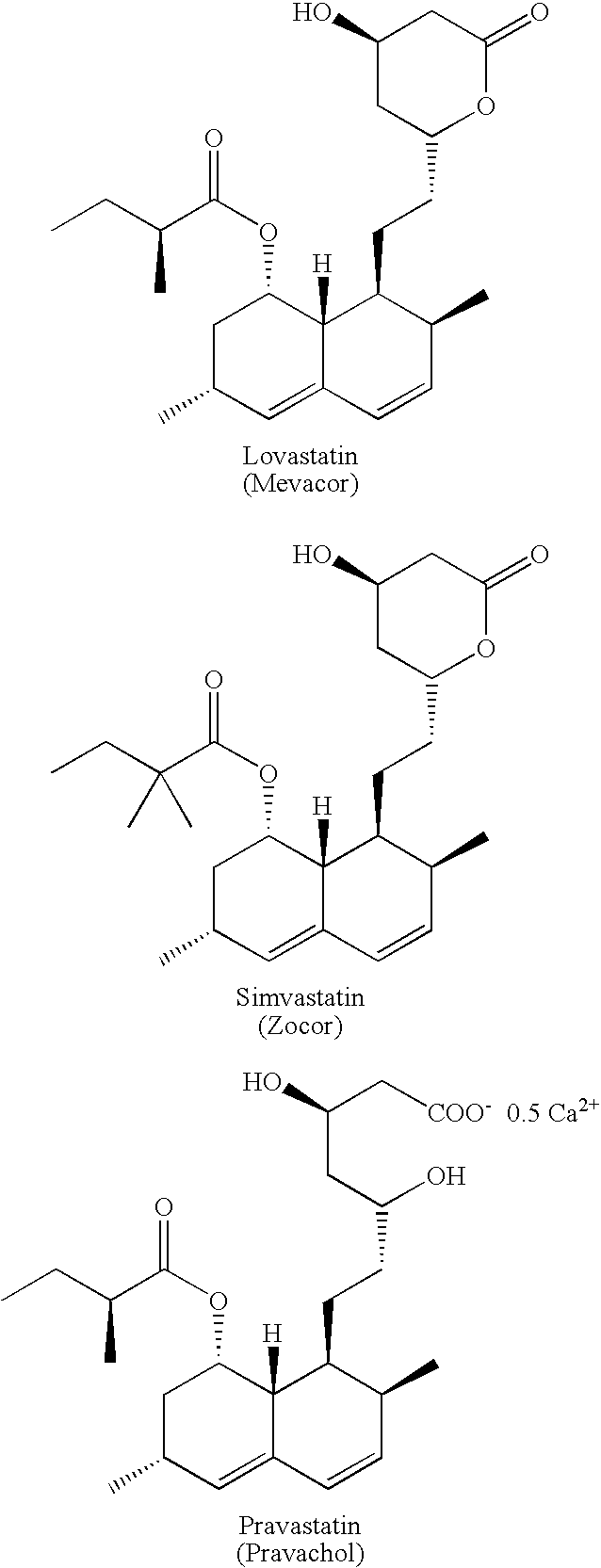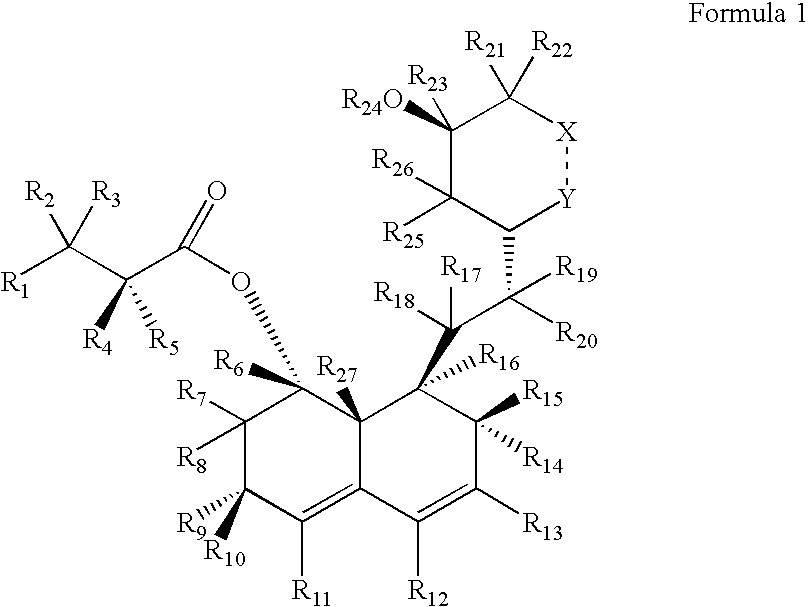Preparation and utility of hmg-coa reductase inhibitors
a reductase inhibitor and hmgcoa technology, applied in the field of preparation and utility of hmgcoa reductase inhibitors, can solve the problems of posing a significant health risk, unstable or unstable metabolites, and multiple or high daily doses
- Summary
- Abstract
- Description
- Claims
- Application Information
AI Technical Summary
Problems solved by technology
Method used
Image
Examples
example 1
d3-2-Methyl-butyric acid 8-{2-[4-(tert-butyl-dimethyl-silanyloxy)-6-oxo-tetrahydro-pyran-2-yl]-ethyl}-3,7-dimethyl-6-oxo-1,2,3,4,6,7,8,8a-octahydro-naphthalen-1-yl ester
[0218]
[0219]The starting material for this reaction is prepared according to methods described by Senanayake et al, Tetrahedron Letters 1993, 34(38), 6021-6024, which is hereby incorporated by reference in its entirety. A solution of 2-methyl-butyric acid-8-{2-[4-(tert-butyl-dimethyl-silanyloxy)-6-oxo-tetrahydro-pyran-2-yl]-ethyl}-7-methyl-6-oxo-1,2,6,7,8,8a-hexahydro-naphthalen-1-yl ester (1 mmol) in dry Et2O (10 mL) at −78° C. is treated with ethereal lithium d6-dimethyl copper (2 mmol) for 30 minutes. The reaction is quenched with saturated aqueous ammonium chloride to produce a crude mixture containing the desired but unstable, unconjugated intermediate. The mixture is then stirred in acidic chloroform to allow the double bond to migrate into conjugation with the carbonyl group, producing the desired product, d3-...
example 2
d3-2-Methyl-butyric acid 8-{2-[4-(tert-butyl-dimethyl-silanyloxy)-6-oxo-tetrahydro-pyran-2-yl]-ethyl}-3,7-dimethyl-6-trifluoromethanesulfonyloxy-1,2,3,7,8,8a-hexahydro-naphthalen-1-yl ester
[0220]
[0221]A solution of d3-2-methyl-butyric acid-8-{2-[4-(tert-butyl-dimethyl-silanyloxy)-6-oxo-tetrahydro-pyran-2-yl]-ethyl}-3,7-dimethyl-6-oxo-1,2,3,4,6,7,8,8a-octahydro-naphthalen-1-yl ester (1 mmol) in CH2Cl2 (10 mL) is cooled to 0° C., and then treated with freshly distilled trifluoromethanesulfonic anhydride (1 mmol) and di-2,6-tert-4-methylpyridine (1 mmol). The reaction is stirred for ˜15 minutes to afford the desired diene triflate which is used in the next step without further purification.
example 3
d3-2-Methyl-butyric acid 8-{2-[4-(tert-butyl-dimethyl-silanyloxy)-6-oxo-tetrahydro-pyran-2-yl]-ethyl}-3,7-dimethyl-1,2,3,7,8,8a-hexahydro-naphthalen-1-yl ester
[0222]
[0223]A solution of d3-2-methyl-butyric acid-8-{2-[4-(tert-butyl-dimethyl-silanyloxy)-6-oxo-tetrahydro-pyran-2-yl]-ethyl}-3,7-dimethyl-6-trifluoromethanesulfonyl-oxy-1,2,3,7,8,8a-hexahydro-naphthalen-1-yl ester (1 mmol) in DMF (10 mL) is treated with palladium acetate (10 mol %), tributylamine (1.1 mmol), and formic acid (1.1 mmol). The mixture is heated to 60° C. for 1 h to afford the desired product, d3-2-Methyl-butyric acid 8-{2-[4-(tert-butyl-dimethyl-silanyloxy)-6-oxo-tetrahydro-pyran-2-yl]ethyl}-3,7-dimethyl-1,2,3,7,8,8a-hexahydro-naphthalen-1-yl ester.
PUM
| Property | Measurement | Unit |
|---|---|---|
| time | aaaaa | aaaaa |
| temperature | aaaaa | aaaaa |
| weight | aaaaa | aaaaa |
Abstract
Description
Claims
Application Information
 Login to View More
Login to View More - R&D
- Intellectual Property
- Life Sciences
- Materials
- Tech Scout
- Unparalleled Data Quality
- Higher Quality Content
- 60% Fewer Hallucinations
Browse by: Latest US Patents, China's latest patents, Technical Efficacy Thesaurus, Application Domain, Technology Topic, Popular Technical Reports.
© 2025 PatSnap. All rights reserved.Legal|Privacy policy|Modern Slavery Act Transparency Statement|Sitemap|About US| Contact US: help@patsnap.com



